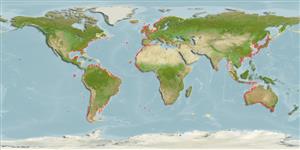Common names from other countries
Classification / Names / Names
आम नाम | उपशब्द | Catalog of Fishes (gen., sp.) | ITIS | CoL | WoRMS
Environment: milieu / climate zone / depth range / distribution range
पारिस्थितिकी
; गहराई सीमा 0 - 32 m (Ref. 87801). Tropical
Indo-Pacific, Atlantic Ocean and the Mediterranean.
Length at first maturity / आकार / वज़न / Age
Maturity: Lm ? range ? - ? cm Max length : 0.3 cm WD पुल्लिंग / अलिंग; (Ref. 2992)
Minimum depth from Ref. 116013. Benthic, found on hard substrate (Ref. 116013). This species is found on polychaete tubes, dead gorgonians, wood and dock chains at depths of 10 to 32 m (Ref. 87801).
Life cycle and mating behavior
परिपक्व अवधि | पुनरुत्पत्ति | मछलीऔ का अंडे देना | अंडे | Fecundity | लार्वा
Species exhibits both asexual and sexual reproduction by budding during hydroid stage and release of gametes in medusae stages (Ref. 1663, p. 14, 17).
Cairns, S.D., D.R. Calder, A. Brinckmann-Voss, C.B. Castro, D.G. Fautin, P.R. Pugh, C.E. Mills, W.C. Jaap, M.N. Arai, S.H.D. Haddock and D.M. Opresko. 2003. (Ref. 1663)
IUCN Red List Status (Ref. 130435)
CITES status (Ref. 108899)
Not Evaluated
Not Evaluated
Human uses
| FishSource |
साधन
अधिक जानकारी
Age/Size
बाढ़
Length-weight
Length-length
आकृति विज्ञान
लार्वा
बहुतायत
इंटरनेट स्रोत
Estimates based on models
Preferred temperature
(Ref.
115969): 7.6 - 28, mean 18.7 (based on 822 cells).
Vulnerability
Low vulnerability (10 of 100).
Price category
Unknown.
